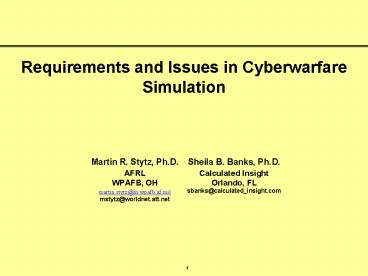Requirements and Issues in Cyberwarfare Simulation PowerPoint PPT Presentation
1 / 14
Title: Requirements and Issues in Cyberwarfare Simulation
1
Requirements and Issues in Cyberwarfare Simulation
2
Introduction
- Cyberwarfare ? Any type of hostile activity or
defense involving computer systems, computer
networks, and/or computerized databases - A subset of information assurance security
- Apparently, strategic and tactical advantages
accrue to combatant able to successfully engage
in cyberwarfare - Need defense against attack, attack assessment,
attack response, operation under attack, attack
resilience - Simultaneously, vulnerability of systems is
increasing - Interconnectivity
- System complexity
- Distributed simulation can provide an environment
for the development and evaluation of
technologies for cyberwarfare operations
3
Issues Problems
- To date, ad hoc/point-wise defense solutions
- Single operators and limited interaction during
attack - Limited capability to detect respond to
large-scale attacks - No rigor
- Difficult to gain insight into the strengths and
weaknesses of defense capabilities - Evaluation only occurs after a real-world attack
- Traditional offensive/defensive ratios/success
expectations do not apply - Offense is inexpensive, defense is very expensive
- Attacks are increasing in their sophistication
and breadth - Cost of traditional testing and evaluation is
prohibitive
4
Focus Areas/Insights
- In the real-world
- Single intrusion detection systems,
single-layered defenses, and human controlled
responses are inadequate - Need to focus on development of
- Distributed detection systems
- Automated, intelligent responses
- Improved command and control capabilities
- Intrusion tolerant systems
- Defensive layering technologies
- Metrics for assessment of performance of a
defensive technology/strategy - Cyberdefense system development environment
5
Why Distributed Simulation?
- Computational scaling
- Lower cost than real world
- Standardized environment necessary to execute
experiments - Ease problems associated with integrating new
software - Real-time performance and interaction is
required, which cant be achieved with a single
system
6
Uses for Distributed Simulation
- Experimentation
- Training
- Strategy and tactics development
- Support development and analysis of analytic
tools, decision support tools, and intelligent
agents - Develop and evaluate tools for cyber command and
control - Attack simulation
- Metrics development, evaluation, and comparison
7
Cyberwarfare Simulation Requirements
- The distributed simulation environment must
support experimentation on tools and technologies - Support evaluation of strategies, tactics, and
decision support systems - Provide a realistic portrayal of response to
attack and defense - Provide a realistic model of network connectivity
and computer hardware systems - Provide a realistic portrayal of the software in
operation at each defending node - Provide realistic portrayal of the human behavior
of commanders and information users
8
Cyberwarfare Simulation Requirements (cont.)
- Common development environment
- Host development, support analysis, support
evaluation, and provide defense system
development tools - HLA standards, FOM, and SOM support
9
Cyberwarfare Common Development Environment
- Contains tools that guides designer and developer
in assembling defensive tools - Agents to provide assistance and evaluation
- Common software architecture and design to enable
rapid assembly - Support sharing/reuse of software and experience
- Aid in development of a security aware software
architecture design methodology - Aid in data acquisition and analysis
- Automate use and evaluation of metrics
10
Simulation Needs
- Support experimentation on all defensive
technologies - Evaluation of offensive and defensive strategies
and tactics - Threat evaluation and vulnerability assessment
- Realistic models of involved networks
- Models of software activity
- Models of infrastructure, vulnerabilities, and
effect of attack - Human behavior models for attackers and defenders
- Common development environment
11
Research Topics
- Experimentation
- Standardized, controlled environment
- Strategic intrusion assessment tools
- Collaborative mobile, intelligent agents
- Detect, evaluate, manage
- Collaborative intrusion detection tools
- Human-human and agent-human
- Attack modeling technologies
- Metrics
- Situation awareness tools
- Models of human reaction to cyberattack
- Defensive technology evaluation
- Methods and procedures
12
Research Topics (cont.)
- Ontology development
- Degree of autonomy to be relegated to agents
- Models of human instigators of harassment attacks
- Visualization tools data mining tools
- Intent determination
13
HLA Issues
- Cyberwarfare simulation introduces a new class of
interactions - Modeling and simulation challenges
- Bandwidth, computational resources, and database
resources - Movement of attacking software, movement of
attack indications, and movement of offensive and
defensive command and control commands - Quality of service
- Specifying activity, types of vulnerabilities,
time required for an attack to succeed - Cyberwarfare simulation has characteristics of
constructive, real-time, analysis, and
engineering HLA environments - Aggregation and de-aggregation of attacked
systems
14
Conclusions and Future Work
- Distributed simulation can aid in development of
cyberwarfare technologies - HLA should be used to support these simulation
environments - Need to develop a set of use cases that describe
cyberwarfare in broad - Reference FOM for cyberwarfare simulation

